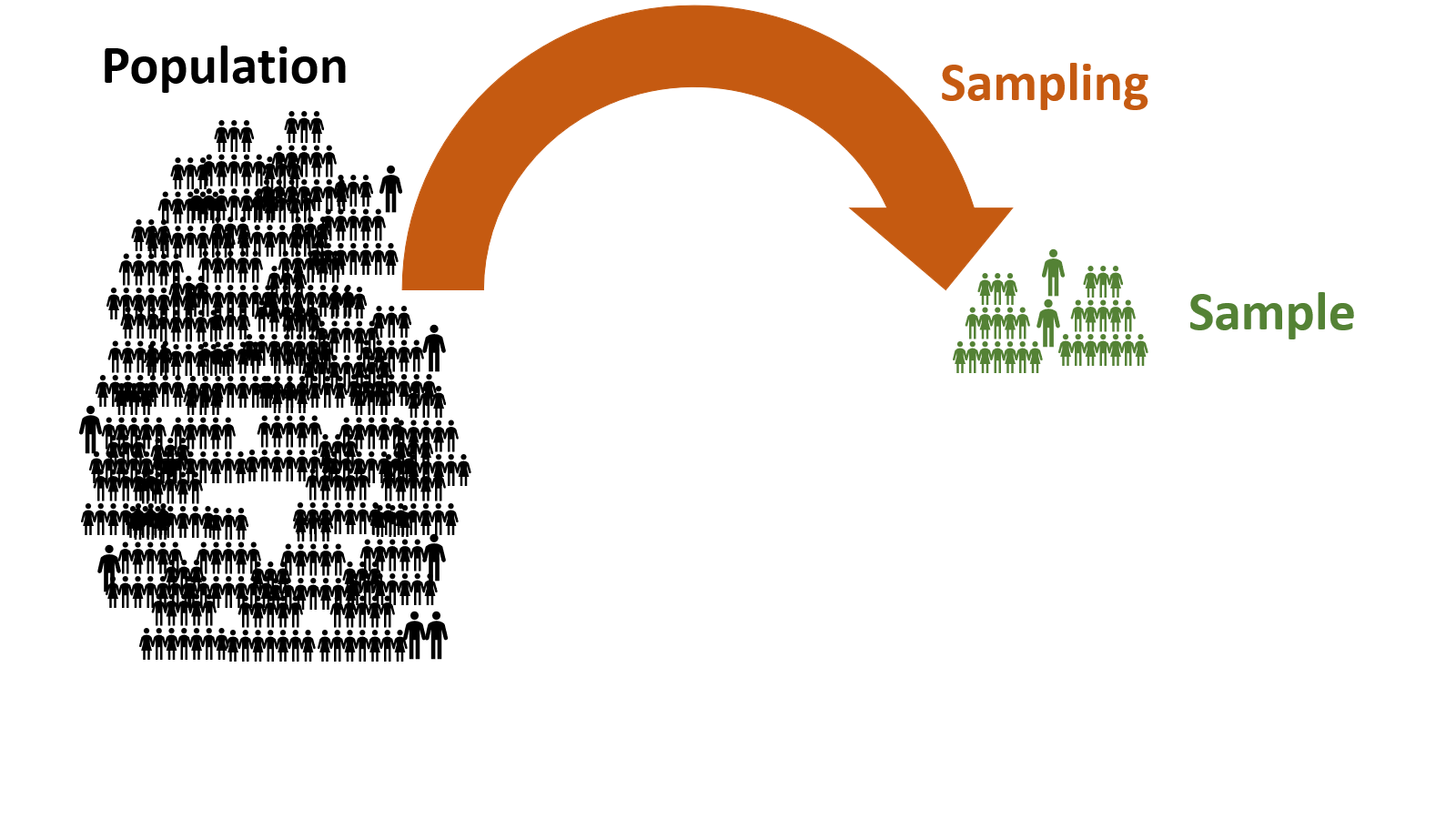7 Sampling Techniques

7.1 Random versus Nonrandom Sampling
Random sampling: A sampling method in which every unit of population has a known probability of being selected for the sample,
Nonrandom sampling: A sampling method in which every unit of the population has unkown probability of being selected for the sample.
7.2 Sampling Frame
A list of the items or people forming a population from which a sample is taken.
7.3 Random Sampling Techniques
Simple random sampling
- Each unit of the population has an equal probability of being selected.
Example:
A wildlife researcher wants to estimate the average weight of adolescent elephants in the Pinnewala Elephant Orphanage.
The population of adolescent elephants is approximately 50 individuals.
Procedure:
Assign each adolescent elephant a unique ID from 1 to 50.
Use a random number generator or lottery method to select 10 elephants.
Measure the weight of the selected elephants.
Stratified random sampling
Population is divided into strata (subgroups) based on characteristics (e.g., species, age, sex).
Random samples are drawn from each stratum proportional to its size.
Within each stratum: individuals are relatively homogeneous (similar).
Between strata: individuals are relatively heterogeneous (different).
Example
A wildlife researcher wants to study the average weight of adolescent elephants at the Pinnewala Elephant Orphanage.
Total population of adolescent elephants: 50
Strata based on sex:
Males: 30
Females: 20
Sampling Plan:
Randomly select a proportional sample from each stratum:
6 males (20% of 30)
4 females (20% of 20)
Systematic random sampling
Systematic sampling selects every k-th individual from a population .
- Ensures the sample is spread evenly across the population.
- Simple to implement, especially in the field.
Steps
Determine the total population size N and the desired sample size n.
Calculate the sampling interval:
k = \frac{N}{n}
Randomly select a starting point between 1 and k.
Select every k-th individual thereafter until the sample size n is reached.
Example
A researcher wants to estimate the average wheat yield in a large farm that has 1,000 wheat plots.
Steps using systematic sampling:
Determine sample size: Suppose the researcher wants to sample 50 plots.
Calculate the sampling interval k
k = \frac{ \text{Total number of plots}}{\text{Sample ize}} = \frac{1000}{50} = 20
Randomly select a starting point from 1 to k: For example, randomly pick plot number 7 as the starting plot.
Select every k-th plot: From the starting plot, select every 20th plot: plot 7, plot 27, plot 47, plot 67, … up to 50 plots.
Collect data: Measure the yield from each selected plot.
Cluster sampling
Cluster sampling divides the population into (groups), often based on geography or natural grouping. Some clusters are randomly selected, and are studied.
Useful when the population is large and spread over a wide area.
Reduces time and travel costs compared to simple random sampling.
Steps
- Divide the population into clusters.
- Randomly select a subset of clusters.
- Include all individuals from the selected clusters in the sample.
7.4 Nonrandom Sampling Techniques
Covenience sampling
Samples are selected based on ease of access or availability.
Advantages: Quick and inexpensive.
Disadvantages: High risk of bias; not representative of the entire population.
Example
A researcher studies the frogs only in the pond near the research station, because it is easily accessible, rather than sampling all ponds in the area.
Judgement sampling
The researcher uses expert knowledge or judgment to select the most relevant or typical subjects.
Advantages: Focused on specific traits or behaviors; useful for rare or specialized cases.
Disadvantages: Subjective; results cannot be generalized to the population.
Example
A researcher wants to study the reproductive behavior of mature elephants. Only adult, healthy elephants are selected based on expert judgment, ignoring juveniles or sick individuals.
Quota sampling
The population is divided into subgroups, and the researcher selects a fixed number of subjects from each subgroup.
Advantages: Ensures representation of important subgroups.
Disadvantages: Nonrandom selection within subgroups may introduce bias.
Example
A researcher wants to study male and female adolescent elephants:
Total population: 50 elephants
Quota: 30 males and 20 females
The researcher selects individuals to meet the quota, not randomly within each sex.
Snowball sampling
Snowball sampling is a non-probability sampling technique in which existing study participants recruit future participants from among their acquaintances. The sample “snowballs” as more and more participants are referred by those already in the study.
Key Features:
Often used when the population is hard to reach or hidden, such as people with rare diseases, drug users, or marginalized communities.
Starts with a small initial group (called “seeds”) who are known or accessible to the researcher.
Each participant helps identify additional participants, increasing the sample size progressively.
Advantages:
Efficient for reaching difficult-to-access populations.
Can leverage participants’ networks to gain trust and participation.
Disadvantages:
Bias risk: The sample may not represent the entire population, since people tend to refer others similar to themselves.
Dependence on initial participants: If the first “seeds” are not diverse, the sample may be skewed.
Example:
A researcher studying rare medical conditions starts with a few patients at a clinic. Each patient refers other patients they know who have the condition, and the process continues until enough participants are recruited.
7.5 Sampling Error vs Nonsampling error
Sampling error is the difference between a sample and the population it represents, often due to an inadequate sample size and can be reduced by increasing the sample size.
Non-sampling error, on the other hand, includes all other mistakes in a study, such as data entry mistakes, poorly worded questions, or faulty data collection methods.